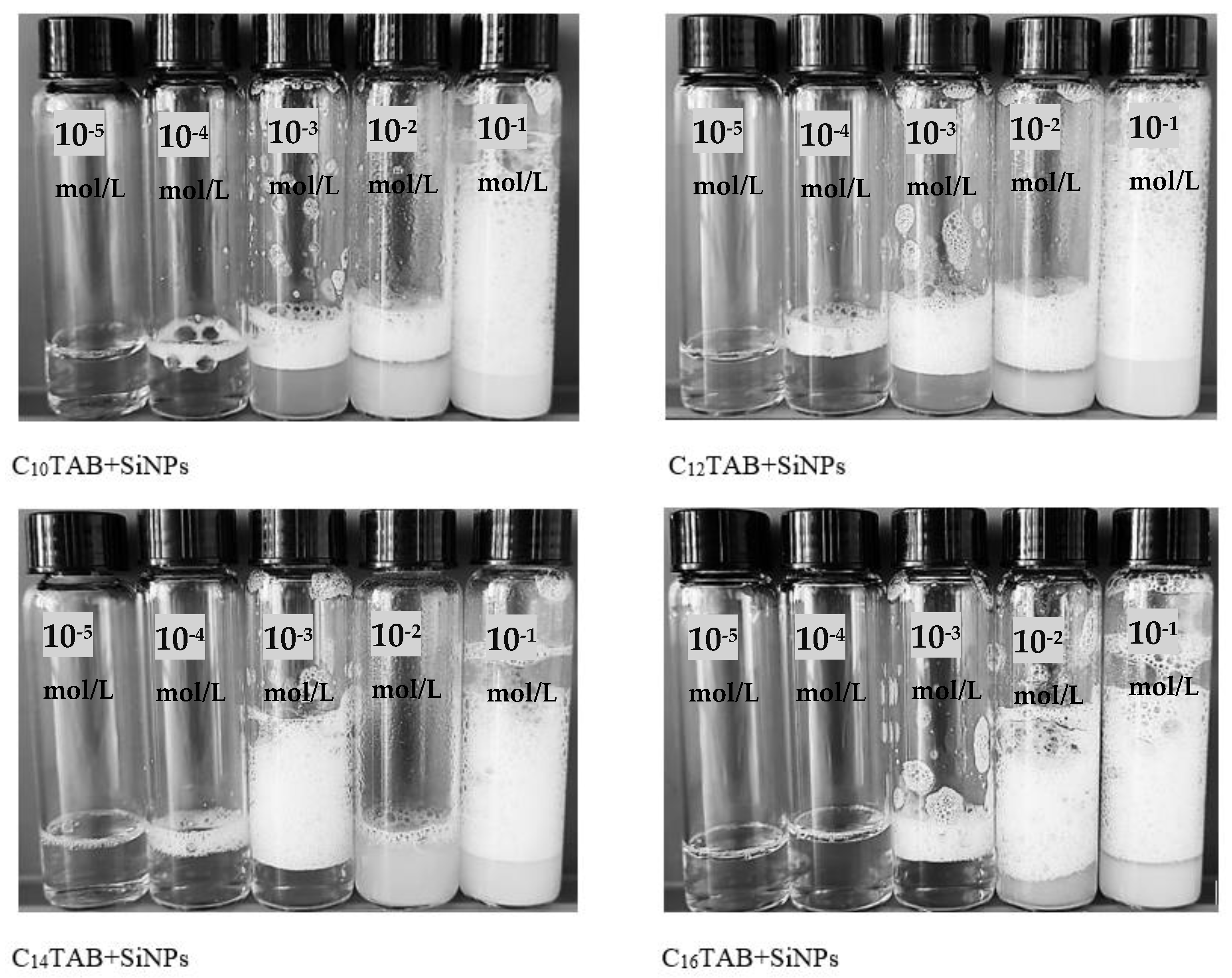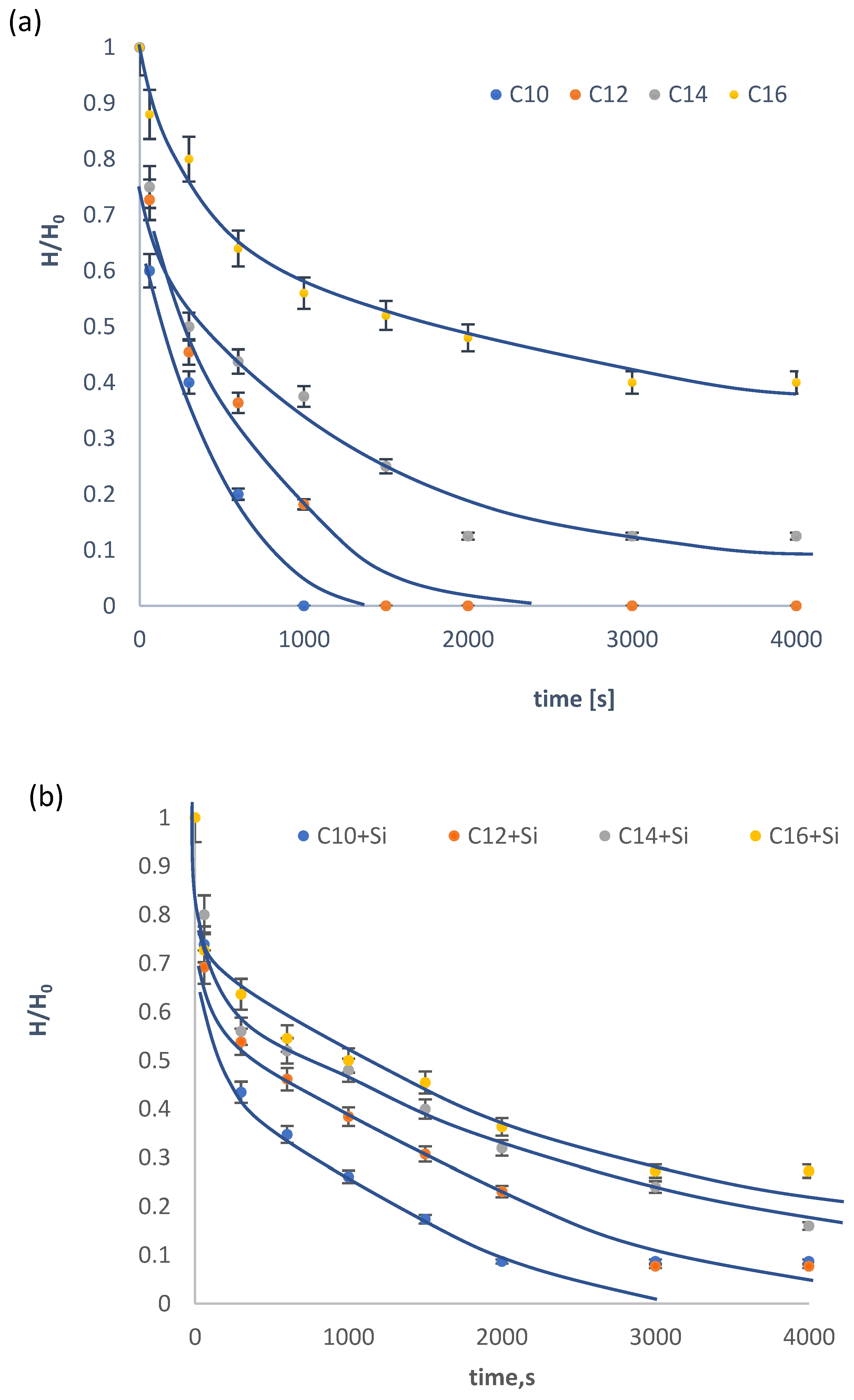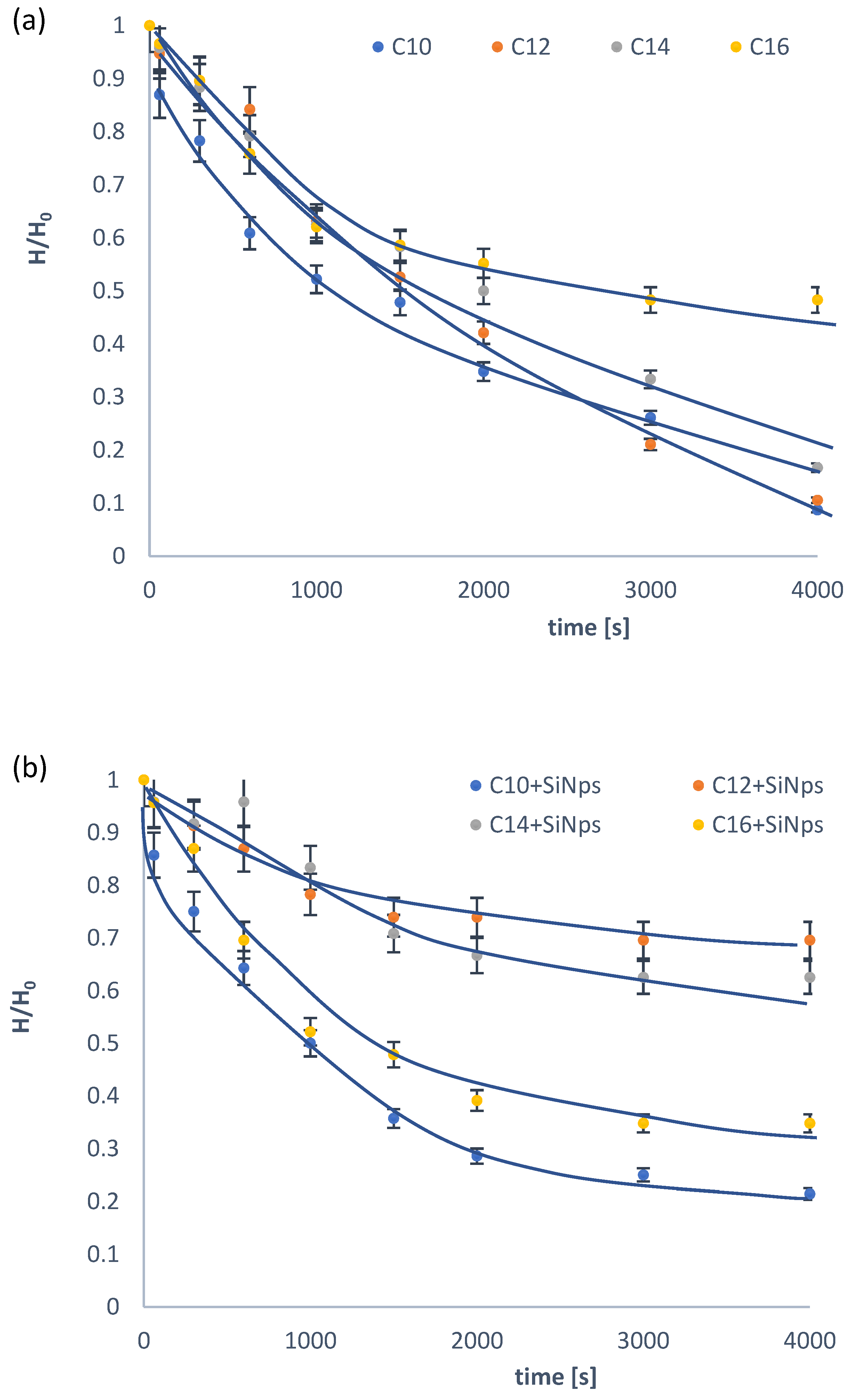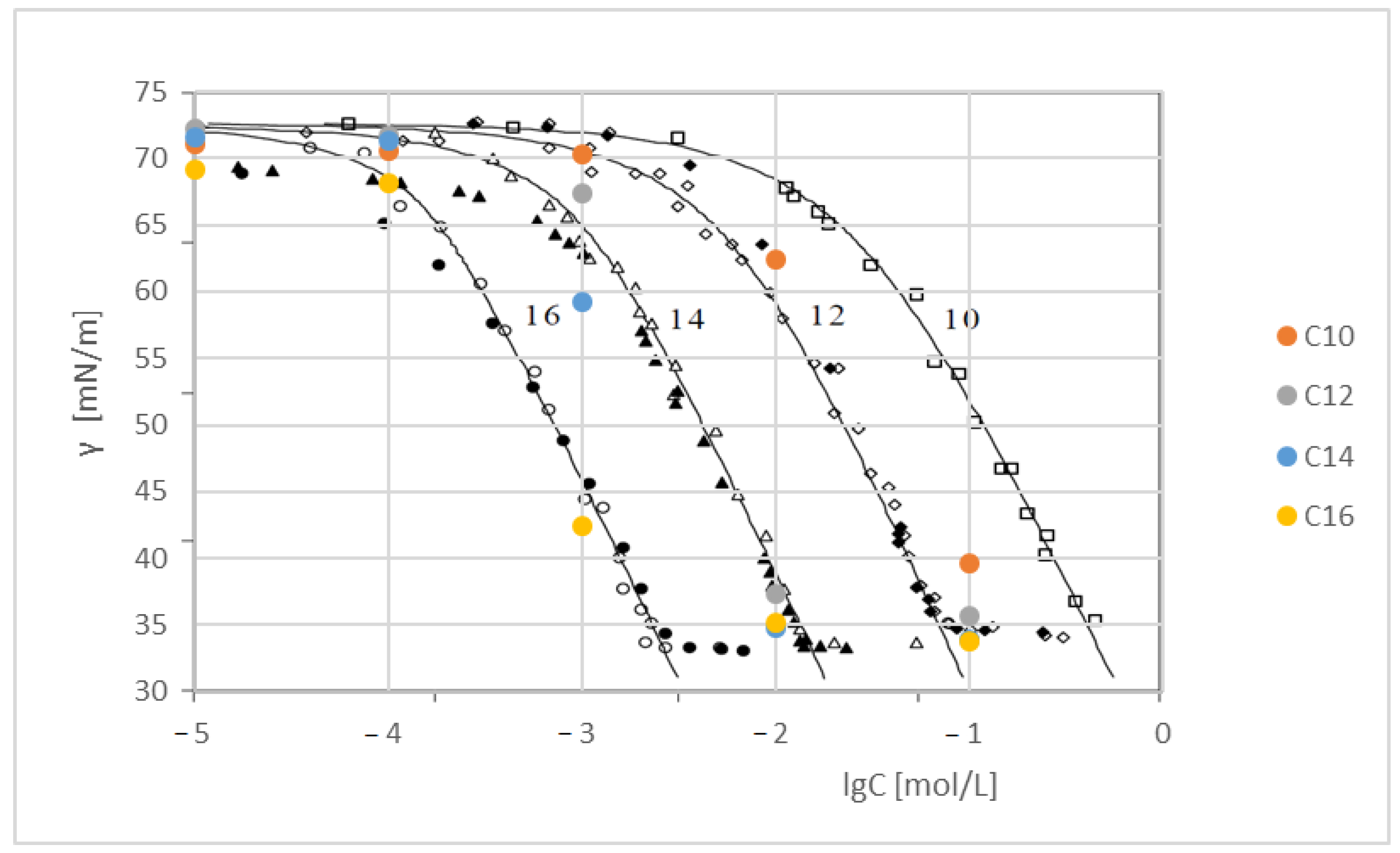Foam Stabilization by Surfactant/SiO2 Composite Nanofluids
Abstract
:1. Introduction
2. Materials and Methods
2.1. Materials
2.2. Apparatus and Methods
2.2.1. Foam Generation and Stability
2.2.2. Zeta Potential Measurements
2.2.3. Measurement of the Surface Tension
2.2.4. Image Analysis and Data Statistics
3. Results
3.1. Foam Formation and Stability by TAB–SiO2 NPs
3.2. Zeta Potential of SiO2 NPs in Aqueous Dispersions
3.3. Dynamic and Equilibrium Surface Tension of Pure TAB and Mixed TAB–SiO2 Solutions
4. Discussion
4.1. TAB–SiO2 NPs Composite Foam Characteristics and Stability
4.2. Mechanism of Foam Stabilization by TAB–SiO2 NPs

5. Conclusions
Author Contributions
Funding
Data Availability Statement
Acknowledgments
Conflicts of Interest
References
- Lindman, B.; Antunes, F.; Aidarova, S.; Miguel, M.; Nylander, T. Polyelectrolyte-surfactant association—From fundamentals to applications. Colloid J. 2014, 76, 585–594. [Google Scholar] [CrossRef]
- Amani, P.; Miller, R.; Javadi, A.; Firouzi, M. Pickering foams and parameters influencing their characteristics. Adv. Colloid Interface Sci. 2022, 301, 102606. [Google Scholar] [CrossRef] [PubMed]
- Yang, W.; Wang, T.; Fan, Z.; Miao, Q.; Deng, Z.; Zhu, Y. Foams stabilized by in situ–modified nanoparticles and anionic surfactants for enhanced oil recovery. Energy Fuel 2017, 31, 4721. [Google Scholar] [CrossRef]
- Farrokhpay, S. The significance of froth stability in mineral flotation. Adv. Colloid Interface 2011, 166, 7. [Google Scholar] [CrossRef]
- Guo, F.; Aryana, S. An experimental investigation of nanoparticle-stabilized CO2 foam used in enhanced oil recovery. Fuel 2016, 186, 42. [Google Scholar] [CrossRef]
- Dickinson, E. Food emulsions and foams: Stabilization by particles. Curr. Opin. Colloid Interface Sci. 2010, 15, 40–49. [Google Scholar] [CrossRef]
- Fakoya, M.F.; Shah, S.N. Emergence of nanotechnology in the oil and gas industry: Emphasis on the application of silica nanoparticles. Petroleum 2017, 3, 391–405. [Google Scholar] [CrossRef]
- Wang, G.; Wang, K.; Lu, C.; Wang, Y. Preparation and foam properties of Janus particles. Chem. J. Chin. Univ. 2018, 39, 990–995. [Google Scholar]
- Rezaei, A.; Derikvand, Z.; Parsaei, F.; Imanivarnosfaderani, M. Surfactant-silica nanoparticle stabilized N-2-foam flooding: A mechanistic study on the effect of surfactant type and temperature. J. Mol. Liq. 2020, 325, 115091. [Google Scholar] [CrossRef]
- Sun, Q.; Li, Z.; Li, S.; Jiang, L.; Wang, J.; Wang, P. Utilization of surfactant-stabilized foam for enhanced oil recovery by adding nanoparticles. Energy Fuels 2014, 28, 2384–2394. [Google Scholar] [CrossRef]
- Almahfood, M.; Bai, B. The synergistic effects of nanoparticle-surfactant nanofluids in EOR applications. J. Pet. Sci. Eng. 2018, 171, 196–210. [Google Scholar] [CrossRef]
- Wasan, D.T.; Nikolov, A.D. Spreading of nanofluids on solids. Nature 2003, 423, 156. [Google Scholar] [CrossRef] [PubMed]
- Stocco, A.; Drenckhan, W.; Rio, E.; Langevin, D.; Binks, B.P. Particle-stabilised foams: An interfacial study. Soft Matter 2009, 5, 2215–2222. [Google Scholar] [CrossRef]
- Dickinson, E.; Ettelaie, R.; Kostakis, T.; Murray, B. Factors controlling the formation and stability of air bubbles stabilized by partially hydrophobic silica nanoparticles. Langmuir 2004, 20, 8517–8525. [Google Scholar] [CrossRef]
- Kim, I.; Worthen, A.J.; Johnston, K.P.; Di Carlo, D.A.; Huh, C. Size-dependent properties of silica nanoparticles for Pickering stabilization of emulsions and foams. J. Nanopart. Res. 2016, 18, 82. [Google Scholar] [CrossRef]
- Fameau, A.L.; Salonen, A. Effect of particles and aggregated structures on the foam stability and aging. C. R. Phys. 2014, 15, 748–760. [Google Scholar] [CrossRef]
- Maestro, A.; Rio, E.; Drenckhan, W.; Langevin, D.; Salonen, A. Foams stabilized by mixtures of nanoparticles and oppositely charged surfactants: Relationship between bubble shrinkage and foam coarsening. Soft Matter 2014, 10, 6975–6983. [Google Scholar] [CrossRef]
- Zhu, Y.; Jiang, J.-Z.; Cui, Z.-G.; Binks, B.P. Responsive Aqueous Foams Stabilized by Silica Nanoparticles Hydrophobized in situ with a Switchable Surfactant. Soft Matter 2014, 10, 9739–9745. [Google Scholar] [CrossRef]
- Verma, A.; Chauhan, G.; Ojha, K. Synergistic effects of polymer and bentonite clay on rheology and thermal stability of foam fluid developed for hydraulic fracturing. Asia-Pac. J. Chem. Eng. 2017, 12, 872–883. [Google Scholar] [CrossRef]
- Santini, E.; Ravera, F.; Ferrari, M.; Alfè, M.; Ciajolo, A.; Liggieri, L. Interfacial properties of carbon particulate-laden liquid interfaces and stability of related foams and emulsions. Colloids Surf. A Physicochem. Eng. Asp. 2010, 365, 189–198. [Google Scholar] [CrossRef]
- Vatanparast, H.; Javadi, A.; Bahramian, A. Silica nanoparticles cationic surfactants interaction in water-oil system. Colloids Surfaces A Physicochem. Eng. Asp. 2017, 521, 221–230. [Google Scholar] [CrossRef]
- Liggieri, L.; Santini, E.; Guzman, E.; Maestro, A.; Ravera, F. Wide-frequency dilational rheology investigation of mixed silica nanoparticle—CTAB interfacial layers. Soft Matter 2011, 7, 7699–7709. [Google Scholar] [CrossRef]
- Calzolari, D.C.E.; Pontoni, D.; Deutsch, M.; Reichert, H.; Daillant, J. Nanoscale structure of surfactant-induced nanoparticle monolayers at the oil—Water interface. Soft Matter 2012, 8, 11478–11483. [Google Scholar] [CrossRef]
- Wang, W.; Gu, B.; Liang, L.; Hamilton, W.A. Adsorption and Structural Arrangement of Cetyltrimethylammonium Cations at the Silica Nanoparticle-Water Interface. J. Phys. Chem. B 2004, 108, 17477–17483. [Google Scholar] [CrossRef]
- Cui, Z.; Yang, L.; Cui, Y.; Binks, B.P. Effects of Surfactant Structure on the Phase Inversion of Emulsions Stabilized by Mixtures of Silica Nanoparticles and Cationic Surfactant. Langmuir 2010, 26, 4717–4724. [Google Scholar] [CrossRef] [PubMed]
- Santini, E.; Krägel, J.; Ravera, F.; Liggieri, L.; Miller, R. Study of the monolayer structure and wettability properties of silica nanoparticles and CTAB using the Langmuir trough technique. Colloids Surf. A Physicochem. Eng. Asp. 2011, 382, 186–191. [Google Scholar] [CrossRef]
- Stamkulov, N.; Mussabekov, K.; Aidarova, S.; Luckham, P. Stabilization of emulsions by using a combination of an oil soluble ionic surfactant and water-soluble polyelectrolytes. I: Emulsion stabilization and Interfacial tension measurements. Colloids Surf. A Physicochem. Eng. Asp. 2009, 335, 103–106. [Google Scholar] [CrossRef]
- Eskandar, N.G.; Simovic, S.; Prestidge, C.A. Synergistic effect of silica nanoparticles and charged surfactants in the formation and stability of submicron oil-in-water emulsions. Phys. Chem. Chem. Phys. 2007, 9, 6426–6434. [Google Scholar] [CrossRef] [PubMed]
- Binks, B.P.; Desforges, A.; Duff, D.G. Synergistic stabilization of emulsions by a mixture of surface-active nanoparticles and surfactant. Langmuir 2007, 23, 1098–1106. [Google Scholar] [CrossRef] [PubMed]
- Binks, B.P.; Rodrigues, J.A.; Frith, W.J. Synergistic interaction in emulsions stabilized by a mixture of silica nanoparticles and cationic surfactant. Langmuir 2007, 23, 3626–3636. [Google Scholar] [CrossRef]
- Wang, H.; Gong, Y.; Lu, W.; Chen, B. Influence of nano-SiO2 on dilational viscoelasticity of liquid/air interface of cetyltrimethyl ammonium bromide. Appl. Surf. Sci. 2008, 254, 3380–3384. [Google Scholar] [CrossRef]
- Badri, V.; Pallab, G. The effect of silica nanoparticles on the stability of aqueous foams. J. Dispers. Sci. Technol. 2019, 40, 206–218. [Google Scholar]
- Choi, M.; Kim, S.E.; Yoon, I.H.; Jung, C.H.; Choi, W.K.; Moon, J.K.; Kim, S.B. Effect of cetyltrimethyl ammonium bromide on foam stability and SiO2 separation for decontamination foam application. J. Nucl. Fuel Cycle Waste Technol. 2018, 16, 173–182. [Google Scholar] [CrossRef]
- Wang, X.; Xu, P.; Xu, M.; Pu, L.; Zhang, Y. Synergistic improvement of foam stability with SiO2 nanoparticles (SiO2-NPs) and different surfactants. Arab. J. Chem. 2023, 16, 104394. [Google Scholar]
- Yekeen, N.; Idris, A.K.; Manan, M.A.; Samin, A.M. Experimental study of the influence of silica nanoparticles on the bulk stability of SDS-foam in the presence of oil. J. Dispersion Sci. Technol. 2017, 38, 416–424. [Google Scholar] [CrossRef]
- Zholob, S.A.; Makievski, A.V.; Miller, R.; Fainerman, V.B. Optimization of calculation methods for determination of surface tensions by drop profile analysis tensiometry. Adv. Colloid Interface Sci. 2007, 134–135, 322–329. [Google Scholar] [CrossRef]
- Mucic, N.; Moradi, N.; Javadi, A.; Aksenenko, E.V.; Fainerman, V.B.; Miller, R. Mixed adsorption layers at the aqueous CnTAB solution/hexane vapour interface. Colloids Surf. A Physicochem. Eng. Asp. 2014, 442, 50–55. [Google Scholar] [CrossRef]
- Mukerjee, P.; Mysels, K.J. Critical Micelle Concentrations of Aqueous Surfactant Systems; National Bureau of Standards: U.S. Government Printing Office: Washington, DC, USA, 1971; pp. 104–107. [Google Scholar]
- Aidarova, S.; Sharipova, A.; Krägel, J.; Miller, R. Polyelectrolyte/surfactant mixtures in the bulk and at water/oil interfaces. Adv. Colloid Interface Sci. 2014, 205, 87–93. [Google Scholar] [CrossRef]
- Wu, Y.; Fang, S.; Zhang, K.; Zhao, M.; Jiao, B.; Dai, C. The stability mechanism of nitrogen foam in porous media with silica nanoparticles modified by cationic surfactants. Langmuir 2018, 34, 8015–8023. [Google Scholar] [CrossRef]
- Zargartalebi, M.; Kharrat, R.; Barati, N. Enhancement of surfactant flooding performance by the use of silica nanoparticles. Fuel 2015, 143, 21–27. [Google Scholar] [CrossRef]
- Vincent, B. Early (pre-DLVO) studies of particle aggregation. Adv. Colloid Interface Sci. 2012, 170, 56–67. [Google Scholar] [CrossRef] [PubMed]
- Miller, R.; Alahverdjieva, V.S.; Fainerman, V.B. Thermodynamics and rheology of mixed protein-surfactant adsorption layers. Soft Matter 2008, 4, 1141–1146. [Google Scholar] [CrossRef] [PubMed]








Disclaimer/Publisher’s Note: The statements, opinions and data contained in all publications are solely those of the individual author(s) and contributor(s) and not of MDPI and/or the editor(s). MDPI and/or the editor(s) disclaim responsibility for any injury to people or property resulting from any ideas, methods, instructions or products referred to in the content. |
© 2023 by the authors. Licensee MDPI, Basel, Switzerland. This article is an open access article distributed under the terms and conditions of the Creative Commons Attribution (CC BY) license (https://creativecommons.org/licenses/by/4.0/).
Share and Cite
Amankeldi, F.; Issakhov, M.; Pourafshary, P.; Ospanova, Z.; Gabdullin, M.; Miller, R. Foam Stabilization by Surfactant/SiO2 Composite Nanofluids. Colloids Interfaces 2023, 7, 57. https://doi.org/10.3390/colloids7030057
Amankeldi F, Issakhov M, Pourafshary P, Ospanova Z, Gabdullin M, Miller R. Foam Stabilization by Surfactant/SiO2 Composite Nanofluids. Colloids and Interfaces. 2023; 7(3):57. https://doi.org/10.3390/colloids7030057
Chicago/Turabian StyleAmankeldi, Fariza, Miras Issakhov, Peyman Pourafshary, Zhanar Ospanova, Maratbek Gabdullin, and Reinhard Miller. 2023. "Foam Stabilization by Surfactant/SiO2 Composite Nanofluids" Colloids and Interfaces 7, no. 3: 57. https://doi.org/10.3390/colloids7030057
APA StyleAmankeldi, F., Issakhov, M., Pourafshary, P., Ospanova, Z., Gabdullin, M., & Miller, R. (2023). Foam Stabilization by Surfactant/SiO2 Composite Nanofluids. Colloids and Interfaces, 7(3), 57. https://doi.org/10.3390/colloids7030057






